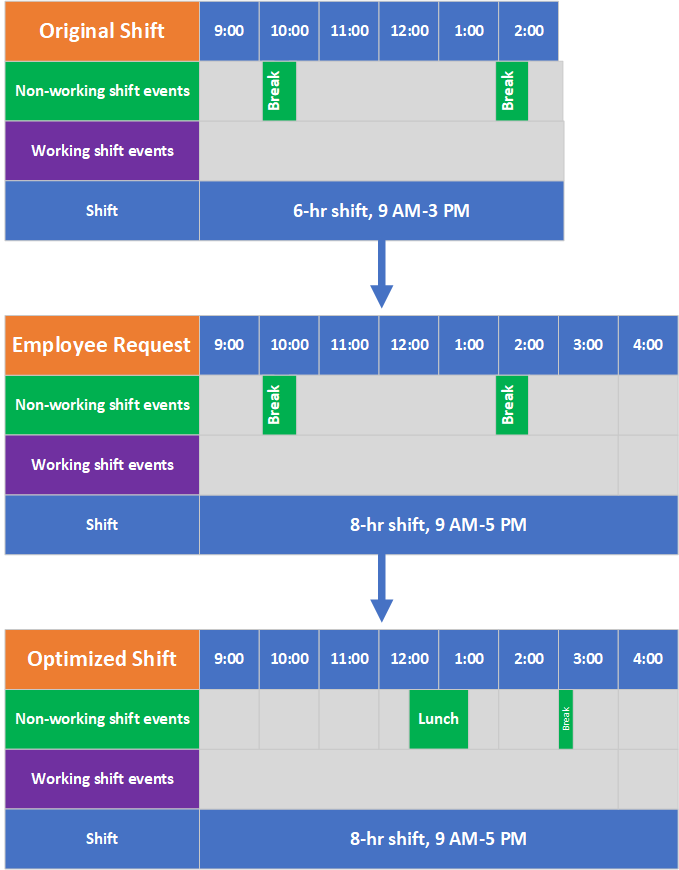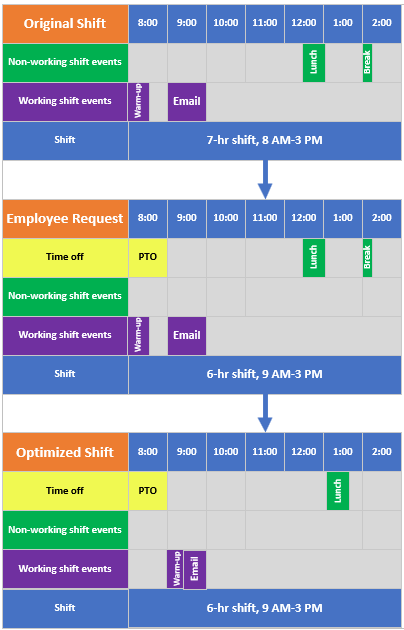Shift optimization examples
Examples of the shift Work period in WFM that has a definite length. optimization process provide scenarios that are helpful in understanding how the system applies shift optimization rules to shift assignments.
Example: Shift optimization of non-working shift events
-
The original shift is six hours long with two half-hour breaks.
-
The employee submits a request to extend the shift by two hours (with no gap), making the shift 8 hours long.
-
A shift optimization rule, called 8–9 hr shift, defines that for shifts with a duration of 8-9 hours, the system should apply the breaks defined in the shift template, Shift_8_hours_with_break. The breaks defined in this template include an hour Lunch and a 15-minute Break.
-
After the 8–9 hr shift rule is applied, the updated shift:
-
Is eight hours long, from 9:00 AM - 5:00 PM
-
Has a Lunch shift event Time period in WFM when employees are scheduled for specific activities, other than the main shift activity. Shift events can either be productive or unproductive, and can be associated with activities such as Phone, Email, Break and Lunch. from 12:30-1:30 PM
-
Has a Break shift event from 3:00-3:15 PM
-

Example: Shift optimization of working shift events
-
The original shift is seven hours long, from 8:00 AM - 3:00 PM. The activities in the original shift are the following:
-
8:00-8:30: Warm-up, a working shift event.
-
8:30-9:00: Phone, the primary activity Core component of both schedules and time records in Workforce Management (WFM). When an employee performs any kind of work, activities specify the scheduled work and capture employee adherence to their schedule. of the shift.
-
9:00-10:00: Email, a working shift event, added as an exception.
-
10:00-12:30: Phone, the primary activity of the shift.
-
12:30-1:00: Lunch, a non-working shift event.
-
1:00-2:00: Phone, the primary activity of the shift.
-
2:00-2:15: Break, a non-working shift event.
-
2:15-3:00: Phone, the primary activity of the shift.
-
-
The employee submits a request to include a time-off event from 8:00-9:00 AM.
-
A shift optimization rule, called 6-hour shift, defines that for shifts with a duration of 6 hours, the system should apply the shift events defined in the shift template, Shift_6_hours. The shift events defined in this template include the Warm-up working shift event at the beginning of the shift, and the non-working shift event, Lunch.
-
After the 6-hour shift rule is applied, the updated shift has the following activities:
-
8:00-9:00: PTO, a time-off event.
-
9:00-9:30: Warm-up, a working shift event.
-
9:30-10:00: Email, a working shift event (exception from original shift).
-
10:00-1:00: Phone, the primary activity of the shift.
-
1:00-1:30: Lunch, a non-working shift event.
-
1:30-3:00: Phone, the primary activity of the shift.

-
Example: Shift optimization rules effect on gaps
-
An original shift is 6 hours with a Lunch non-working shift event from 12:00-1:00 PM.
-
An employee submits a request to extend the shift by two hours, and asks to include a 30-minute gap between the original shift and the extension.
-
For the first 6-hour shift segment, the system applies the shift optimization rule, 6-hr shift, which defines a shift template for shifts with a duration of six hours. This shift template includes a 30-minute lunch, which is now applied to the updated shift segment.
-
For the second 2-hour shift segment, the system applies the shift optimization rule, 2-hr shift, which defines a shift template for shifts with a duration of two hours. This shift template includes one 15-minute break, which is now applied to the updated shift segment.
Example: Time off request updated by a shift optimization rule
The employee's shift is four hours (1 PM - 5 PM) with a paid, 15-minute break.
|
Action by |
Description |
|---|---|
|
Employee |
Employee requests two hours (3 PM - 5 PM) of vacation during this shift. |
|
System |
Removes the paid, 15-minute break. The employee must work four consecutive hours to receive a paid break. |
Example: Shift Request & Change updated by a shift optimization rule
The employee's shift is four hours (8 AM - noon) with a scheduled paid, 15-minute break.
|
Action by |
Description |
|---|---|
|
Employee |
Requests two more hours at the end of their shift. Total shift is six hours (8 AM - 2 PM). |
|
System |
Adds an unpaid, 30-minute lunch along with the already scheduled paid, 15-minute break. |
Example: Shift Request & Change updated by shift optimization rule
The employee's shift is four hours (8 AM - noon) with a scheduled paid, 15-minute break.
|
Action by |
Description |
|---|---|
|
Employee |
Requests an extra hour (7 AM - 8 AM) before their shift. The shift totals five hours (7 AM - noon). |
|
System |
The system does not change the breaks in the shift. The shift met the continuous shift length condition in the shift optimization rule; however, the shift template provides one paid, 15-minute break for a shift of five consecutive hours. |
|
Then, employee requests another shift change. |
|
|
Employee |
Requests two extra hours (noon - 2 PM) after the shift. The shift totals six hours (7 AM - 2 PM). |
|
System |
Adds an unpaid, 30-minute lunch in addition to the scheduled paid, 15-minute break. |
Example: Shift request & change with working shift events updated by a shift optimization rule
The employee's shift is six hours (8 AM - 2 PM) with a scheduled paid, 15-minute Email working shift event at the beginning of the shift.
|
Action by |
Description |
|---|---|
|
Employee |
Requests an hour of paid time off at the beginning of their shift, from 8 AM - 9 AM. |
|
System |
Verifies that the Email working shift event is defined in the shift template and is eligible to be optimized, and if it is, adds a paid time-off event from 8 AM - 9 AM, and schedules a 15-minute Email working shift event from 9:00-9:15 AM. |
Example: Shift request & change updated by a shift optimization rule
The employee's shift is four hours (5 PM - 9 PM) with a scheduled paid, 15-minute break.
|
Action by |
Description |
|---|---|
|
Employee |
Requests an extra two hours ( 9 PM - 11 PM) at the end of the shift. The shift totals six hours (5 PM - 11 PM). |
|
System |
Adds an unpaid, 30-minute lunch along with the already scheduled paid, 15-minute break. |
|
Next, the employee submits a withdrawal request. |
|
|
Employee |
Requests to withdraw the two hours (9 PM - 11 PM) from the shift. Now the shift totals four hours (5 PM to 9 PM). |
|
System |
Removes the unpaid, 30-minute lunch. Leaves the scheduled paid, 15-minute break. |
|
Next, the employee creates a gap in the schedule. |
|
|
Employee |
Requests four hours earlier on the same day (8 AM - noon) and keeps the four hours in the evening (5 PM - 9 PM). |
|
System |
Adds a paid, 15-minute break to the mornings shift (8 AM - noon). No changes are made to the shift from 5:00 PM and 9 PM. |
|
Next, the employee fills the gap. |
|
|
Employee |
Requests two more hours (noon - 2 PM) at the end of their morning shift and keeps the four hours in the evening. The first shift is now a total of six hours (8 AM - 2 PM). |
|
System |
Adds an unpaid, 30-minute lunch in addition to a paid, 15-minute break between 8 AM and 2 PM. No changes are made to the morning shift. It still has one paid, 15-minute break. |
Shift optimization rules overview